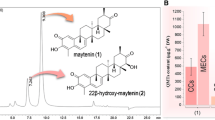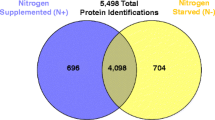Abstract
A proteomic approach is undertaken aiming at the identification of novel proteins involved in the alkaloid biosynthesis of Catharanthus roseus. The C. roseus cell suspension culture A11 accumulates the terpenoid indole alkaloids strictosidine, ajmalicine and vindolinine. Cells were grown for 21 days, and alkaloid accumulation was monitored during this period. After a rapid increase between day 3 and day 6, the alkaloid content reached a maximum on day 16. Systematic analysis of the proteome was performed by two-dimensional polyacrylamide gel electrophoresis. After day 3, the proteome started to change with an increasing number of protein spots. On day 13, the proteome changed back to roughly the same as at the start of the growth cycle. 88 protein spots were selected for identification by mass spectrometry (MALDI-MS/MS). Of these, 58 were identified, including two isoforms of strictosidine synthase (EC 4.3.3.2), which catalyzes the formation of strictosidine in the alkaloid biosynthesis; tryptophan synthase (EC 4.1.1.28), which is needed for the supply of the alkaloid precursor tryptamine; 12-oxophytodienoate reductase, which is indirectly involved in the alkaloid biosynthesis as it catalyzes the last step in the biosynthesis of the regulator jasmonic acid. Unique sequences were found, which may also relate to unidentified biosynthetic proteins.





Similar content being viewed by others
Abbreviations
- IPG:
-
Immobilized pH gradient
- 2D-PAGE:
-
Two-dimensional polyacrylamide gel electrophoresis
- MALDI-TOF:
-
Matrix assisted laser desorption ionization time of flight
- MS:
-
Mass spectrometry
References
Clauser KR, Baker P, Burlingame AL (1999) Role of accurate mass measurement (+/− 10 ppm) in protein identification strategies employing MS or MS/MS and database searching. Anal Chem 71:2871–2882
Contin A, van der Heijden R, Lefeber AWM, Verpoorte R (1998) The iridoid glucoside secologanin is derived from the novel triose phosphate/pyruvate pathway in a Catharanthus roseus cell culture. FEBS Lett 434:413–416
Contin A, van der Heijden R, ten Hoopen HJG, Verpoorte R (1999) The inoculum size triggers tryptamine or secologanin biosynthesis in Catharanthus roseus cell cultures. Plant Sci 139:205–211
Dagnino D, Schripsema J, Verpoorte R (1996) Analysis of several iridoid and indole precursors of terpenoid indole alkaloids with a single HPLC run. Planta Med 62:278–280
De Waal A, Meijer AH, Verpoorte R (1995) Strictosidine synthase from Catharanthus roseus: purification and characterization of multiple isoforms. Biochem J 306:571–580
Decker G, Wanner G, Zenk MH, Lottspeich F (2000) Characterization of proteins in the latex of of the opium poppy (Papaver somniferum) using two-dimensional electrophoresis and microsequencing. Electrophoresis 21:3500–3516
Douce R, Bourguignon J, Neuburger M, Rébeillé R (2001) The glycine decarboxylase system: a fascinating complex. Trends Plant Sci 6:167–176
Gamborg OL, Miller RA, Ojima K (1968) Nutrient requirements of suspension cultures of soybean root cells. Exp Cell Res 50:151–158
Görg A, Obermaier C, Boguth G, Harder A, Scheibe B, Wildgruber R, Weiss W (2000) The current state of two-dimensional electrophoresis with immobilized pH gradients. Electrophoresis 21:1037–1053
Granier F (1988) Extraction of plant proteins for two-dimensional electrophoresis. Electrophoresis 9:712–718
Ho C-L, Saito K (2001) Molecular biology of the plastidic phosphorylated serine biosynthetic pathway in Arabidopsis thaliana. Amino Acids 20:243–259
Jacobs DI, van der Heijden R, Verpoorte R (2000) Proteomics in plant biotechnology and secondary metabolism research. Phytochem Anal 11:277–287
Jacobs DI, van Rijssen MS, van der Heijden R, Verpoorte R (2001) Sequential solubilization of proteins precipitated with trichloroacetic acid in acetone from cultured Catharanthus roseus cells yields 52% more spots after two-dimensional electrophoresis. Proteomics 1:1345–1350
Laemmli UK (1970) Cleavage of structural proteins during the assembly of the head of bacteriophage T4. Nature 277:680–685
Memelink J, Verpoorte R, Kijne JW (2001) ORCAnization of jasmonate-responsive gene expression in alkaloid metabolism. Trends Plant Sci 6:212–219
Moreno PRH, van der Heijden R, Verpoorte R (1993) Effect of terpenoid precursor feeding and elicitation on formation of indole alkaloids in cell suspension cultures of Catharanthus roseus. Plant Cell Rep 12:702–705
Perkins DN, Pappin DJ, Creasy DM, Cottrell JS (1999) Probability-based protein identification by searching sequence databases using mass spectrometry data. Electrophoresis 20:3551–3567
Peterson G L (1977) A simplification of the protein assay method of Lowry et al which is more generally applicable. Anal Biochem 83:346–356
Rappsilber J, Mann M (2002) What does it mean to identify a protein in proteomics? Trends Biochem Sci 27:74–78
Rohmer M (1999) The discovery of a mevalonate-independent pathway for isoprenoid biosynthesis in bacteria, algae and higher plants. Nat Prod Rep 16:565–574
Shevchenko A, Wilm M, Vorm O, Mann M (1996) Mass spectrometric sequencing of proteins from silver-stained polyacrylamide gels. Anal Chem 68:850–858
Shevchenko A, Sunyaev S, Loboda A, Shevchenko A, Bork P, Ens W, Standing K (2001) Charting the proteomes of organisms with unsequenced genomes by MALDI-quadrupole time-of-flight mass spectrometry and BLAST homology searching. Anal Chem 73:1917–1926
Van der Fits L, Memelink J (2000) ORCA3, a jasmonate-responsive transcriptional regulator of plant primary and secondary metabolism. Science 289:295–297
Van der Heijden R, Lamping PJ, Out PP, Wijnsma R, Verpoorte R (1987) High performance liquid chromatographic determination of indole alkaloids in a cell suspension culture of Tabernaemontana divaricata. J Chromatogr 396:287–295
Van der Heijden R, Jacobs DI, Snoeijer W, Hellerd D, Verpoorte R (2004) The Catharanthus alkaloids: pharmacognosy and biotechnology. Curr Med Chem 11:1241–1253
Verpoorte R, van der Heijden R, Moreno PRH (1997) Biosynthesis of terpenoid indole alkaloids in Catharanthus roseus cells. In: Cordell GA (ed) The alkaloids, vol 49. Academic, San Diego, pp 221–299
Verpoorte R, van der Heijden R, ten Hoopen HJG, Memelink J (1999) Metabolic engineering of plant secondary metabolite pathways for the production of fine chemicals. Biotechnol Lett 21:467–479
Whitmer S, Canel C, Hallard D, Goncalves C, Verpoorte R (1998) Influence of precursor availability on alkaloid accumulation by transgenic cell lines of Catharanthus roseus. Plant Physiol 116:853–857
Acknowledgements
The authors would like to thank the Van Leersumfonds (the Netherlands) to make the purchase of an IPGphor and MALDI-sample plates possible.
Author information
Authors and Affiliations
Corresponding author
Rights and permissions
About this article
Cite this article
Jacobs, D.I., Gaspari, M., van der Greef, J. et al. Proteome analysis of the medicinal plant Catharanthus roseus. Planta 221, 690–704 (2005). https://doi.org/10.1007/s00425-004-1474-4
Received:
Accepted:
Published:
Issue Date:
DOI: https://doi.org/10.1007/s00425-004-1474-4




